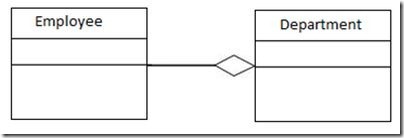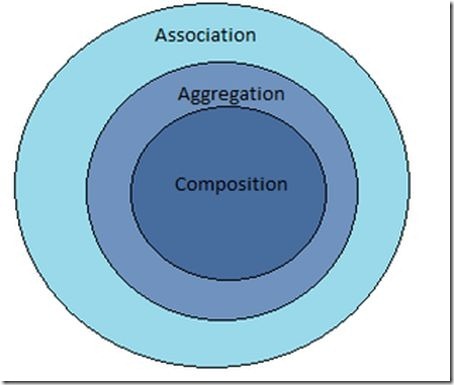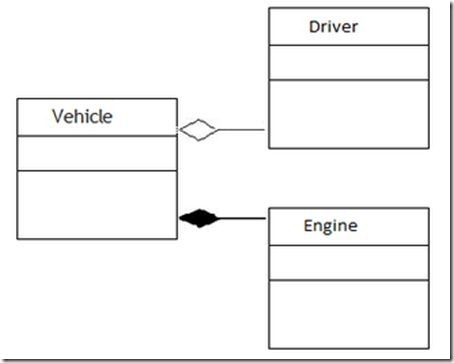关联,聚合和组合(复合)--Association, Aggregation and Composition
概要
Association, Aggregation and Composition are terms that represent relationships among objects. They are very basic stuff of Object Oriented Programming.
关联
Association is a relationship among the objects. Association is "*a*" relationship among objects. In Association, the relationship among the objects determine what an object instance can cause another to perform an action on its behalf. We can also say that an association defines the multiplicity among the objects. We can define a one-to-one, one-to-many, many-to-one and many-to-many relationship among objects. Association is a more general term to define a relationship among objects. Association means that an object "uses" another object.
For example Managers and Employees, multiple employees may be associated with a single manager and a single employee may be associated with multiple managers.
聚合
Aggregation is a special type of Association. Aggregation is "*the*" relationship among objects. We can say it is a direct association among the objects. In Aggregation, the direction specifies which object contains the other object. There are mutual dependencies among objects.
For example, departments and employees, a department has many employees but a single employee is not associated with multiple departments.
UML Representation of Aggregation (white diamond):
The UML representation of the example above (relation between employee and department):
Here, the lives of both objects are independent of each other. That means that in this Association (Aggregation) the object has their own life cycle. Employees may exist without a department. Here, department can be called an owner object and the employee can be called a child object. The owner and child objects cannot belong to a different parent object.
组合(复合)
Composition is special type of Aggregation. It is a strong type of Aggregation. In this type of Aggregation the child object does not have their own life cycle. The child object's life depends on the parent's life cycle. Only the parent object has an independent life cycle. If we delete the parent object then the child object(s) will also be deleted. We can define the Composition as a "Part of" relationship.
For example, the company and company location, a single company has multiple locations. If we delete the company then all the company locations are automatically deleted. The company location does not have their independent life cycle, it depends on the company object's life (parent object).
UML Representation of Composition (black diamond):
UML representation of the example above (relation between Company and Company Location):
Here, the lives of both objects are not independent. The life of the company location object can be determined by the life of the company object. The company object is responsible for creating and destroying company location objects.
关联,聚合和组合三者之间的关系图

Aggregation and Composition are a special type of Association. Composition is again a special type of Aggregation. We can define Aggregation and Composition as "has a" relationships. Composition is more restrictive or more specific. In Composition, composed objects cannot exist without the other object. This type of restriction does not exist in Aggregations. In Aggregation, the existence of a composed object is optional. In Aggregation, the child object can exist beyond the life cycle of its parent whereas in Composition the child object cannot exist beyond the life cycle of its parent.
Combined example of Aggregation and Composition:
聚合VS组合
| Aggregation | Composition |
| Aggregation is a special type of Association. | Composition is a special type of Aggregation. |
| All objects have their own life cycle. | In Composition, the child object does not have their own life cycle and it depends on the parent's life cycle. |
| A parent class is not responsible for creating or destroying the child class. | The parent class is responsible for creating or destroying the child class. |
| Aggregation can be described as a "Has-a" relationship. | Composition can be described as a "Has-a" relationship as well as a "Part of" relationship, but here the difference is the length of the relationship among the objects. |
| Aggregation is a weak Association. | Composition is a strong Association. |
| Aggregation means one object is the owner of another object. | Composition means one object is contained in another object. |
| The direction of a relation is a requirement in both Composition and Aggregation. The direction specifies which object contains the other one. | |
| Both have a single direction of association. | |
| Both have a single owner. | |
结论
These three terms are more important in the object oriented world. They denote or represent the relations among objects. If you are confused or unable to decide whether a specific relation best describes an Association, Aggregation or Composition then it can be decribed as an Association.
引用:http://www.c-sharpcorner.com/UploadFile/ff2f08/association-aggregation-and-composition/
关联,聚合和组合(复合)--Association, Aggregation and Composition的更多相关文章
- UML类关系:依赖,关联,聚合和组合
UML图示例:(可使用StartUML来画图,小巧^_^) http://www.blogjava.net/lukangping/archive/2010/08/01/327693.html 聚合:表 ...
- Inheritance, Association, Aggregation, and Composition 类的继承,关联,聚合和组合的区别
在C++中,类与类之间的关系大概有四种,分别为继承,关联,聚合,和组合.其中继承我们大家应该都比较熟悉,因为是C++的三大特性继承Inheritance,封装Encapsulation,和多态Poly ...
- UML类关系(依赖,关联,聚合,组合,泛化,实现)
转自https://blog.csdn.net/k346k346/article/details/59582926 在学习面向对象设计时,类关系涉及依赖.关联.聚合.组合和泛化这五种关系,耦合度依 ...
- UML类图关系(泛化 、继承、实现、依赖、关联、聚合、组合)
UML类图关系(泛化 .继承.实现.依赖.关联.聚合.组合) 继承.实现.依赖.关联.聚合.组合的联系与区别 分别介绍这几种关系: 继承 指的是一个类(称为子类.子接口)继承另外的一个类(称为父类.父 ...
- java--依赖、关联、聚合和组合之间区别的理解
在学习面向对象设计对象关系时,依赖.关联.聚合和组合这四种关系之间区别比较容易混淆.特别是后三种,仅仅是在语义上有所区别,所谓语义就是指上下文环境.特定情景等. 依赖(Dependency)关系是类与 ...
- java_UML:继承/泛化、实现、依赖、关联、聚合、组合的联系与区别 (2016-07-12)
分别介绍这几种关系: UML关系:继承(泛化).实现.依赖.关联.聚合.组合的联系与区别 一.表示符号上的区别 二.具体区别与联系 1. 继承/泛化(Generalization) [泛化关系]:是一 ...
- UML[1] UML类图关系(泛化 、继承、实现、依赖、关联、聚合、组合)(转)
转自:http://blog.csdn.net/zhaoxu0312/article/details/7212152 继承.实现.依赖.关联.聚合.组合的联系与区别 分别介绍这几种关系: 继承 指的是 ...
- UML图中类之间的关系:依赖,泛化,关联,聚合,组合,实现
UML图中类之间的关系:依赖,泛化,关联,聚合,组合,实现 类与类图 1) 类(Class)封装了数据和行为,是面向对象的重要组成部分,它是具有相同属性.操作.关系的对象集合的总称. 2) 在系统中, ...
- UML类图及依赖,泛化,关联,聚合,组合,实现
UML图中类之间的关系:依赖,泛化,关联,聚合,组合,实现 类与类图 1) 类(Class)封装了数据和行为,是面向对象的重要组成部分,它是具有相同属性.操作.关系的对象集合的总称. 2) 在系统中, ...
随机推荐
- Spark基本概念快速入门
Spark集群 一组计算机的集合,每个计算机节点作为独立的计算资源,又可以虚拟出多个具备计算能力的虚拟机,这些虚拟机是集群中的计算单元.Spark的核心模块专注于调度和管理虚拟机之上分布式计算任务 ...
- httpClient的post方法使用form格式数据调用接口
Http使用post调用接口,接口只接受form表单数据格式问题? 这个问题的关键是form表单提交的是数据格式是什么样子的,使用httpClient工具类时Header信息如何写. 会影响解决问题思 ...
- Keystone Federation Identity
转自 http://wsfdl.com/openstack/2016/01/14/Keystone-Federation-Identity.html Keystone federation ident ...
- 自动化收集SQLSERVER诊断信息
自动化收集SQLSERVER诊断信息 相信很多人都遇到过当SQLSERVER出现问题的时候,而你又解决不了需要DBA或者微软售后支持工程师 去帮忙解决问题,那么他们一般需要你收集一些系统信息和SQ ...
- 配置web项目出的各种error (安装sql2008错误,网站连接数据库error错误等等)
一个破error:40 错误搞出了很多莫名其妙的为问题,搞了5天,最后重装系统加上重新配置终于好了. 1. 关于SQL 2008 安装错误 安装之前必须安装VS2008 SP1 安装到最后提示 试 ...
- Oracle删除步骤
1.Oracle卸载要求比较严格,不能简单的卸载就完事了:当然Oracle卸载也没有那么难,只是步骤比较多.Oracle10g还是Oracle11g卸载步骤都是一样的.下边详细介绍一下. 找到Orac ...
- uva 10739 dp
https://vjudge.net/problem/UVA-10739 和昨天的那个回文串几乎一样只是加了条件限制,可以随意增删以及替换. #include<iostream> #inc ...
- uva 1025 A Spy int the Metro
https://vjudge.net/problem/UVA-1025 看见spy忍俊不禁的想起省赛时不知道spy啥意思 ( >_< f[i][j]表示i时刻处于j站所需的最少等待时间,有 ...
- JavaWeb学习总结(二) Servlet
本文目录 一.Servlet概述 二.Servlet接口 三.GenericServlet 四.HttpServlet 五.Servlet细节 六.ServletContext 回到顶部 一.Serv ...
- Memorial for Nanjing victims today 南京大屠杀死难者公祭仪式今于南京举行 勿忘国耻,活捉小*日*本。
China will hold an annual memorial for the victims of the Nanjing Massacre today in the eastern city ...
